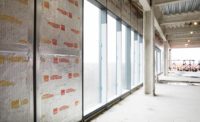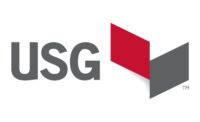NAU Services Building Makes the Grade








Northern Arizona University (NAU) needed a structure to bring together, in a single building, several service departments that were previously in various locations around the Flagstaff campus. Today the University Services Building houses office and administrative space for the NAU’s marketing, fundraising, accounting, information technology, and its foundation personnel. Although this project was challenged by a tight budget, limited space, and a very aggressive timeline, all goals were achieved.
Completed in September 2012 at a cost of nearly $12,000,000, this 45,000-square-foot, three-story building was designed and built to LEED Silver certification standards.
The Evolving Design
Under a design/build agreement, M.A. Mortenson and SmithGroupJJR, were commissioned to provide design and construction services for Northern Arizona Real Estate Holdings and Northern Arizona University. Ron Ensley, Senior Project Manager, LEED AP, Phoenix Operating Group of M.A. Mortenson said the challenges for the design/construction team on the Northern Arizona University Services Building project were speed to market, the competitive cost, and the University’s design standards.
M.A. Mortenson Construction is a diversified construction firm with over 2,000 team members in 48 states and select international locations. It offers services in general construction, construction management, program management, design-build, project development, and turnkey development. In a joint agreement with SmithGroupJJR, the parameters for the project were designed to meet NAU’s rugged requirements.
“In the case of the Kingspan insulated metal panels, NAU required compliance with their design standards, that could still meet an extremely aggressive schedule days from awarding the design-build project to having an operational facility turned over and in use by several Northern Arizona University departments,” says Ensley. “Working with (the company), Mortenson was able to forego the typical enclosure metal stud framing system and directly apply the metal panels to the building’s structural frame.
Creativity in design was made possible by specifying insulated metal panels on this project. The exterior look of the building was given greater depth by using the two different insulated panel systems with complimenting colors. Punched windows were incorporated into the east and west elevations of the building with a large curtain wall on the north and south.
Further design features of the NAU Services Building were added by using insulated metal panels. “We specified the insulated metal panels to be prime painted on the interior side so the only finish required from the interior of the building was the final coat of paint, said Ensley. “From the exterior of the building, we were able to use IMPs in multiple colors to accentuate a 40-foot cantilevered overhang and building entry. The long, vertical panel lines were able to tie in the wooded site.”
The Better Wall
Eric Jurus, the regional sales manager for the manufacturer, together with Kovach Inc., based in Chandler, Az., coordinated the exterior cladding installation. “Installing Kingspan insulated metal panels gave the competed building a higher R-value than what would have been possible in a conventional design,” says Jurus. According to Scott Bourdo, president of Kovach Inc., the walls were originally designed using concrete tilt panels with metal panel accents. “The issue with the concrete tilt panels was the required laydown space needed as the jobsite had a very small footprint,” he recalls. “So we recommended the quickness of a steel structure and Kingspan insulated wall panels fastened directly to the wind girts that would provide an exterior façade, waterproofing, and a paintable interior wall surface all in one product.”
Kovach installed 4800 square-feet of 24-inch KS Mini Micro Rib (Bright Silver) and 14,700 square-feet of 36-inch KS Micro-Rib (Charcoal) on the NAU Services Building. Bourdo said that there were three main benefits for specifying the insulated metal panels. “The project had a very demanding six-month schedule, from the first day of turning dirt to Certificate of Occupancy,” says Bourdo. “Several key trades, including Kovach, were brought in by Mortenson and SmithGroupJJR to develop an overall envelope that would meet design intent, performance requirements, and maintain that 6-month schedule for this 12 million dollar building.”
Time and Space
Using insulated metal panels saved approximately three weeks on the schedule in the framing activities and dramatically lowered costs for the enclosure. The facility was constructed on time while meeting the aggressive design-build budget.
Scott Bourdo, of Kovach Inc., further noted that the faster speed of installation, thanks to the use of the insulated metal panels, allowed the building to be dried in quickly. Interior trades were able to start work immediately after elevations of the building were complete.
In addition to these time constraints, the issue of space was another one resolved by using the company’s products. The facility was located on a previously wooded site with many developed trees the building had to contend with. “Many other enclosure systems were reviewed, but due to a very tight, grade-related constraint, a system that could be hoisted into place without excess waste or site utilization was necessary,” says Ensley.
IMPs In The Future
“New stringent building codes will increase the use of insulated metal panels to solve flame spread, and address waterproofing, insulation, diaphragm, and longevity concerns,” Bourdo says. “I believe these products have the ability to replace conventional 16 inches-on-center framing, fluid applied waterproofing, and blanket insulation assemblies. The flexibility of Kingspan systems and the ability to install complimenting products on the exterior makes insulated panels very attractive to the marketplace, owners, and designers.”
Looking for a reprint of this article?
From high-res PDFs to custom plaques, order your copy today!












